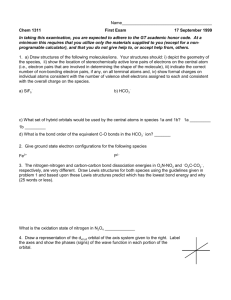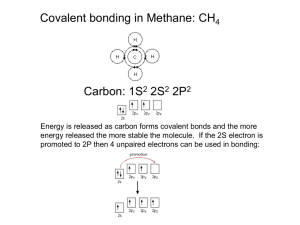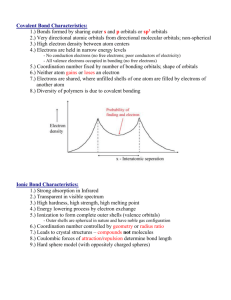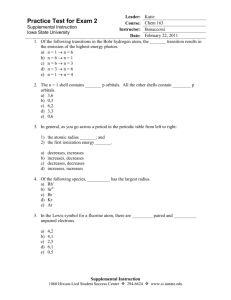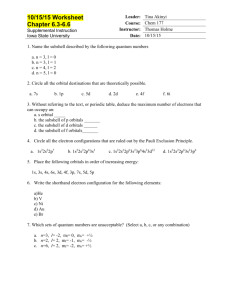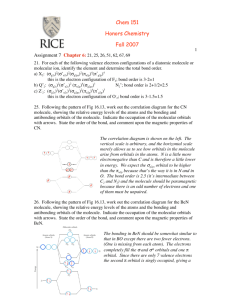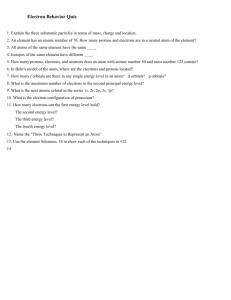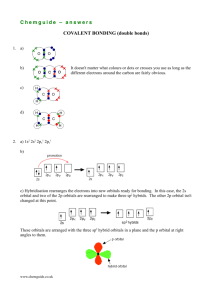Molecular Geometry VSEPR Models 1 VSEPR Models 2
advertisement
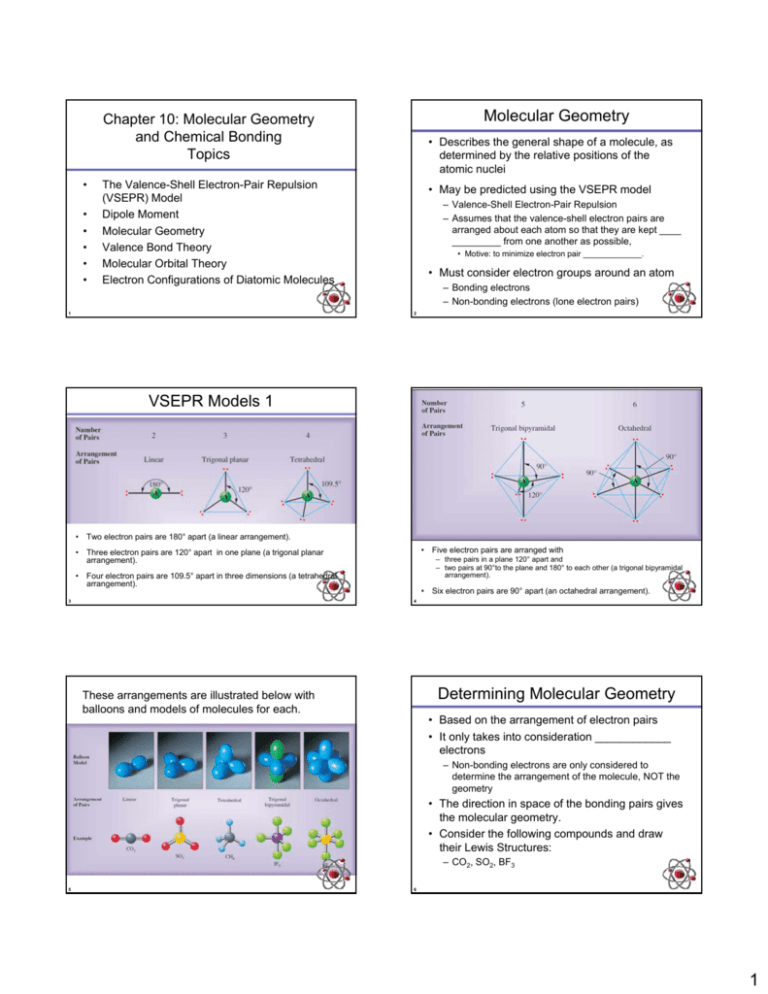
Molecular Geometry Chapter 10: Molecular Geometry and Chemical Bonding Topics • • • • • • • Describes the general shape of a molecule, as determined by the relative positions of the atomic nuclei The Valence-Shell Electron-Pair Repulsion (VSEPR) Model Dipole Moment Molecular Geometry Valence Bond Theory Molecular Orbital Theory Electron Configurations of Diatomic Molecules 1 • May be predicted using the VSEPR model – Valence-Shell Electron-Pair Repulsion – Assumes that the valence-shell electron pairs are arranged about each atom so that they are kept ____ _________ from one another as possible, • Motive: to minimize electron pair _____________. • Must consider electron groups around an atom – Bonding electrons – Non-bonding electrons (lone electron pairs) 2 VSEPR Models 1 VSEPR Models 2 • Two electron pairs are 180° apart (a linear arrangement). • Five electron pairs are arranged with • Three electron pairs are 120° apart in one plane (a trigonal planar arrangement). – three pairs in a plane 120° apart and – two pairs at 90°to the plane and 180° to each other (a trigonal bipyramidal arrangement). • Four electron pairs are 109.5° apart in three dimensions (a tetrahedral arrangement). 3 • Six electron pairs are 90° apart (an octahedral arrangement). 4 Determining Molecular Geometry These arrangements are illustrated below with balloons and models of molecules for each. • Based on the arrangement of electron pairs • It only takes into consideration ____________ electrons – Non-bonding electrons are only considered to determine the arrangement of the molecule, NOT the geometry • The direction in space of the bonding pairs gives the molecular geometry. • Consider the following compounds and draw their Lewis Structures: – CO2, SO2, BF3 5 6 1 Molecular Geometry: 2 and 3 Electron Pairs Determining Molecular Geometry • CO2 O C O – Two double bonds around C – The VSEPR model considers a double or triple bond as though it were one lone pair • Thus two electron groups • SO2 O S O O S O O S O – There are three structures – There are three electron groups around S F • BF3 – B is bonded to three F – There are three electron groups around B F B F 7 8 Molecular Geometry: 5 Electron Pairs Molecular Geometry: 4 Electron Pairs 9 10 Predicting Molecular Geometry Molecular Geometry: 6 Electron Pairs • Write the electron-dot formula – from the chemical formula. • Based on the electron-dot formula: – Determine the number of electron pairs around the central atom (including bonding and nonbonding pairs) – Determine the arrangement of the electron pairs about the central atom (Figure 10.3) – Obtain the molecular geometry from the directions of the bonding pairs for this arrangement (Figure 10.4) 11 12 2 Example 1: AsF3 Example 1: Molecular Geometry • AsF3 has 1(5) + 3(7) = 26 valence electrons; • As is the central atom. • Use the VSEPR model to predict the geometries of the following molecules: a. AsF3 b. PH4+ c. BCl3 F As F F • There are four regions of electrons around As •three bonding pairs •one lone pair • The electron arrangement is:_____________ • It has one lone pair •The molecular geometry is _______________. 13 14 Example 1: PH4+ Example 1: BCl3 • PH4+ has 1(5) + 4(1) – 1 = 9 valence electrons; • P is the central atom. • BCl3 has 1(3) + 3(7) = 24 valence electrons; • B is the central atom. • There are four regions of electrons around P: •four bonding electron pairs. B • There are three regions of electrons around B; all are bonding. • The electron-pairs arrangement is __________ • All regions are bonding, so the molecular geometry is __________________. 15 Cl Cl Cl • The electron-pair arrangement is _____________. 16 Example 2: ICl3 Examples 2: Molecular Geometry • ICl3 has 1(7) + 3(7) = 28 valence electrons. • I is the central atom. • Using the VSEPR model, predict the geometry of the following species: a. ICl3 b. ICl4- Cl Cl • There are five regions: • three bonding • two lone pairs. I Cl • The electron-pair arrangement is _________________. • The geometry is ____________. 17 18 3 Example 2: ICl4• ICl4- has 1(7) + 4(7) + 1 = 36 valence electrons. • I is the central element. Predicting Bond Angles - Cl Cl • There are six regions around I • four bonding • two lone pairs. I • The angles 180°, 120°, 109.5°, and so on are the bond angles when the central atom has no lone pair and all bonds are with the same type of atom. Cl • When this is not the case, the bond angles deviate from these values in sometimes predictable ways. Cl • The electron-pair arrangement is _______________. • The geometry is ___________. • Because a lone pair tends to require more space than a bonding pair, it tends to reduce the bond angles. 19 20 Angles for Tetrahedral Arrangements Effect of Multiple Bonds on Angles Multiple bonds require more space than single bonds and, therefore, constrict the bond angle. 21 22 Dipole Moment Determining Polarity • A quantitative measure of the polarity in a molecule • Depends on the atoms present and the polarity of the bonds in the molecule • First, find the electron-dot formula and the molecular geometry. • Second, use vectors to represent the charge separation of each bond – A polar bond is characterized by separation of electrical charge. – They begin at δ+ atoms and go to δ- atoms. – Recall that vectors have both magnitude and direction. • For HCl, we can represent the charge separation using δ+ and δ- to indicate partial charges. • Third, sum the vectors. – If the sum of the vectors is zero, the dipole moment is __________. – Cl is more electronegative: it has the δ- charge – H has the δ+ charge. 23 δ+ δ- H Cl • Vectors of equal magnitude but opposite direction cancel out – If there is a net vector, the molecule is ________. 24 4 Determining Polarity Example Example 3: Determining Polarity • To illustrate polarity, arrows with a ‘+’ on one end of the arrow are used • Which of these molecules is polar? Cl – You must always consider the geometry of the molecule • Consider CO2 and H2O. – CO2 is linear, and H2O is bent O C H O O The vectors add to zero (cancel) for CO2. Its dipole moment is zero. F H C Cl H H H H 25 S F Cl Cl B Cl F F Cl Cl For H2O, a net vector points up. Water has a dipole moment. I H C H Cl 26 Properties of Polar Compounds • Polar molecules experience attractive forces between molecules; – Thus, they orient themselves in a δ+ to δ- manner. – This has an impact on molecular properties such as boiling point. – The attractive forces due to the polarity lead the molecule to have a higher boiling point. – Consider the following compound, which has two conformations • 1,2-dichloroethene 27 28 Properties of Polar Compounds cis-1,2-dichloroethene + H H C + + Cl + C Cl • Must make use of quantum mechanics • Two theories explain electronic structures of bonds Cl + C + + Cl H trans-1,2-dichloroethene + + C Understanding Bonding Electronics – Valence bond theory H • Overlap of atoms’ Hybrid orbitals result in bonds 29 The net polarity is down; this is a polar molecule. There is no net polarity; this is a nonpolar molecule. Boiling point 60°C. Boiling point 48°C. – Molecular Orbital Theory • New Molecular orbitals are formed from the orbitals of individual atoms 30 5 Valence Bond Theory How Many Bonds can be Formed? • A bond forms between two atoms when: • Chlorine – A portion of two orbitals occupy the same region (they overlap) – __ unpaired electron – forms __ bond (HCl) • The greater the orbital overlap, the ______ the bond • Orbitals (except s orbitals) bond in the direction in which they protrude or point, so as to obtain maximum overlap • Oxygen – __ unpaired electrons – forms __ bonds (H2O) – The total number of electrons in both orbitals is no more than _________. • Carbon 31 32 i d l The Four Bonds of Carbon t Hybrid Orbitals • An electron from the 2s orbital is _______ to the vacant 2p orbital • Upon promotion of an electron, atomic orbitals combine to form ‘new’ orbitals – Process is called ______________ – The new orbitals are called hybrid orbitals • In the case of carbon, – 1 s orbital and 3 p orbitals make 4 sp3 orbitals 33 34 Hybrid Orbitals 2 Spatial arrangement of sp3 hybrid orbitals s-orbital: • Any number and type of orbital is capable of hybridizing p-orbital: – The number of hybrid orbitals formed always equals the number of atomic orbitals used. • Hybrid orbitals are named by using the atomic orbitals that combined: A. One sp3-orbital B. Four sp3-orbital around a nucleus C. Bonding in CH4 • One carbon sp3orbital bonds to one hydrogen sorbital 35 – – – – – 1 s orbital + 1 p orbital = _______ orbitals 1 s orbital + 2 p orbitals = _______ orbitals 1 s orbital + 3 p orbitals = _______ orbitals 1 s orbital + 3 p orbitals + 1 d orbital = _______ orbitals 1 s orbital + 3 p orbitals + 2 d orbitals = ______ orbitals 36 6 Hybrid Orbitals Diagrams Hybrid Orbitals Characteristics 37 38 Obtaining Bond Description In General 1. Write the Lewis electron-dot formula. 2. Use VSEPR to determine the electron arrangement about the atom. Orbital Type sp Orbitals formed Electron groups around atom 2 2 _______ 3. From the arrangement, deduce the hybrid orbitals. sp2 3 3 _______ 4. Assign the valence electrons to the hybrid orbitals one at a time, pairing only when necessary. sp3 4 4 _______ sp3d 5 5 _______ sp3d2 6 6 _______ 5. Form bonds by overlapping singly occupied hybrid orbitals with singly occupied orbitals of another atom. 39 Electron arrangement 40 • The orbital diagram of the ground-state N atom is Example 4: Hybridization • Use valence bond theory to describe the bonding about an N atom in N2H4. F N N F F 1s F 2s 2p • The sp3 hybridized N atom is 1s sp3 • Consider one N in N2F4: • The Lewis electron-dot structure shows three bonds and one lone pair around each N atom. – the two N—F bonds are formed by the overlap of a half-filled sp3 orbital with a half-filled 2p orbital on F. – The N—N bond forms from the overlap of a half-filled sp3 orbital on each. – The lone pair occupies one sp3 orbital. – They have a tetrahedral arrangement. 41 42 7 Example 5: Hybridization Example 5: Hybridization • Hybridization of the s, three p, and one d orbital occurs next • Use valence bond theory to describe the bonding in the ClF2- ion. – Five sp3d hybridized orbitals form, four 3d orbitals remain: – The chlorine must be able to form two bonds. How does it do it? • The valence orbital diagram for the Cl- ion is sp3d 3s 3p 3d • Two Cl—F bonds are formed from the overlap of two half-filled sp3d orbitals with half-filled 2p orbitals on the F atom. 3d • First promotion of one 3p electron occurs to a d orbital: – These use the axial positions of the trigonal bipyramid. – Shape of molecule: linear 3s 3p • Three lone pairs occupy three sp3d orbitals. These are in the equatorial position of the trigonal bipyramid. 3d 43 44 Multiple Bonds Double Bond • One hybrid orbital is required for • Consider ethylene – each bond (whether a single or a multiple bond) – and for each lone pair. H H C C H • Multiple bonding involves the overlap of – one hybrid orbital – and one or two nonhybridized ___ orbitals H • There is one double bond between carbons – Must have one hybridized orbital and one nonhybridized p orbital • For a double bond – Requires bonding via __ nonhybridized p orbital from each atom • There are 4 single bonds with hydrogens • For a triple bond – Formed from hybridized orbitals in carbon – Requires bonding via __ nonhybridized p orbitals from each atom 45 46 Orbital Diagram for C in Ethylene Triple Bond C—C bond between hybridized orbitals (sp2) • Consider acetylene H C C H • There is one triple bond between carbons – Must have one hybridized orbital and ___ nonhybridized p orbital C—C bond between nonhybridized p orbitals • There are 2 single bonds with hydrogens – Formed from hybridized orbitals in carbon 47 48 8 σ-Bonds Orbital Diagram for C in Acetylene • Multiple bonds may be identified as either of these C—C bond between hybridized orbitals (sp) • A σ−bond (sigma) – Has a ____________ shape about the bond axis. – Formed when orbitals overlap along their _______ sp • either when two s orbitals overlap or with directional orbitals (p or hybrid) 2 C—C bonds between nonhybridized p orbitals 49 50 π-Bonds Ethylene and Acetylene • A π−bond (pi) – Has an electron distribution above and below the bond axis. – It is formed by the _____________ overlap of two parallel p orbitals. 51 Ethylene Acetylene ____ σ-bonds ____ σ-bonds ____ π-bond ___ π-bonds 52 O Example 6: Bond Description Example 6 C H • Describe the bonding about the C atom in formaldehyde, CH2O, using valence bond theory. H O • After promotion, the orbital diagram is C H 1s • The electron arrangement is ______________ using sp2 hybrid orbitals. • The ground-state orbital diagram for C is 1s 53 2s H 2s 2p • After hybridization, the orbital diagram is 1s 2p sp2 2p 54 9 O Example 6 Molecular Orbital (MO) Theory C H H • There are _____ σ bonds arising from two C—H bonds • A second theory that explains electronic structure of molecules – For each bond one C sp2 hybrid orbital overlaps with the 1s orbital on the H atoms. – Used to explain bonds between two atoms • As atoms approach one another, their atomic orbitals overlap and form molecular orbitals. • A third ___ bond forms from the C—O bond – Results from the overlap of one sp2 hybrid orbital and one O half-filled p orbital. • The electrons in a bond can be found either – in a region between the nuclei – or as far away from each other as possible • One ___ bond forms for the second C—O bond – from the sideways overlap of the C 2p orbital and an O 2p orbital. 55 56 Bonding and Antibonding Orbitals Applying MO Theory • Once a molecular orbital is formed, it can be occupied in the same way as are atomic orbitals. • If the electrons are between nuclei, – _______ molecular orbitals form – They are obtained by adding atomic orbitals • As an example, we’ll study hydrogen, H2. • Each hydrogen atom has one electron in a 1s orbital, for a total of two electrons. • When the two 1s orbitals combine, they form two σ−molecular orbitals – One is a bonding orbital (represented by σ1s) – One is an antibonding orbital (represented by σ∗1s) • If the electrons are in a region other than between nuclei – _______________ orbitals form – Result from subtraction of atomic orbitals. 57 58 Molecular Orbitals for H2 Molecular Orbitals for H2 • The bonding molecular orbital is lower in energy than the antibonding molecular orbital. • The two electrons are placed in the lower-energy bonding molecular orbital with __________ spin. • The ground-state molecular orbital electron configuration is _________. – Thus bonding MOs fill before antibonding MOs • Each MO is able to hold ______ electrons • We have a total of two electrons in the bond: one from each hydrogen atom 59 – Excited states are also possible 60 10 Molecular Orbitals for He2 Bond Order • Draw the MO diagram for He2 • The number of bonds that exist between two atoms • Each atom has 2 electrons, for a total of 4 electrons He atom σ*1s 1s – Can be calculated using the equation He atom 1s – nb = number of electrons in bonding orbitals – na = number of electrons in antibonding orbitals σ1s • Bond order also tells us about the stability of the bond • The energy decrease from the bonding electrons is offset by the energy increase of antibonding electrons. – If BO = ____, no stable bond forms – Thus, He2 is not a stable molecule • Electron configuration: ______________. 61 62 Bond Order Calculations Conditions for Forming MO • For H2 (two electrons), • The strength of the interaction between two atomic orbitals to form MOs is determined by two factors: – the molecular electron configuration is ______. – Bond order = ½ (2 - 0) = ____. – The energy difference between the interacting orbitals – The magnitude of the overlap • For H2+ (one electron), – the molecular electron configuration is ______. – Bond order = ½ (1 - 0) = ____. • For the interaction to be strong, the energies of the two orbitals must be approximately equal and the overlap must be large • For He2 (four electrons), – the molecular electron configuration is __________. – Bond order = ½(2 - 2) = ____. • This means no bond forms. 63 64 Conditions for Forming MO - Example Li2 • Consider the diatomic molecule Li2 • The two 1s atomic orbitals combine to form two σ MOs: – Each atom has an electron configuration of 1s2 2s1 – ____________. • When the molecule forms, only like atomic orbitals will interact • The two 2s atomic orbitals combine to form two σ MOs: – The ___ orbitals will interact with each other – The ___ orbitals will interact with each other – A 1s orbital of one atom will ____ interact with the 2s orbital of another – _______________. • Each atom has 3 electrons, thus • The energies of each are different 65 – Six electrons occupy the orbitals in order of increasing energy: 66 11 MOs of Be2 Li2 MO Diagram • Determine the molecular electron configuration of Be2 σ 1s σ 1∗s • Be2 has 8 electrons. σ ∗2s σ 2s – The molecular orbital diagram is the same as for Li2. – The eight electrons occupy the orbitals in order of increasing energy: The molecular electron configuration is (σ1s)2(σ1s*)2(σ2s)2 or σ 1s ________ σ 1∗s σ ∗2 s σ 2s • The molecular electron configuration is KK is the abbreviation for (σ1s)2(σ*1s)2 . – (σ1s)2(σ∗1s)2(σ2s)2(σ∗2s)2 Bond order = _______________. or __________________ • The bond order is ___________________. – No bond forms between Be atoms 67 68 MOs from p-Orbitals MOs from p-Orbitals • When atomic p orbitals interact two types of molecular orbitals are formed • When atomic p orbitals interact two types of molecular orbitals are formed – ________ π molecular orbitals form when they overlap sideways – ______ σ molecular orbitals form when they overlap end-to-end • π2p and π*2p • Since there are two sets of p orbitals interacting, each will give two π molecular orbitals for a total of ___ molecular orbitals • σ2p and σ*2p. 69 70 Example 7: MO Diagram of O2 Energetic Diagram of Molecular Orbitals • Relative energies of the molecular orbitals formed from second period atomic orbitals. • Give the orbital diagram and electron configuration of the O2 molecule. • Is the molecular substance diamagnetic or paramagnetic? • What is the order of the bond in this molecule? • The arrows are for N2. • Because there are two bonding π orbitals, they can hold four electrons. – They are filled one electron per orbital – Then a second electron is added to the same orbital with opposite spin. 71 72 12 Example 7: Electron Configuration of O2 Molecular Electron Configuration Shortcut • Order of filling up MOs • O2 has 16 electrons. The KK shell holds 4 electrons so 12 remain. – σ1s σ*1s σ2s σ*2s π2p σ2p π*2p σ*2p – Each MO holds 2 electrons – Thus, each σ subshell holds ___ electrons – And, each π subshell holds ___ electrons The molecular electron configuration is _________________________ The bond order is _______________. • Give the electron configuration of the F2 molecule. • Is the molecular substance diamagnetic or paramagnetic? The molecule is ________________. 73 74 σ*2p Heteronuclear Diatomic Molecules π*2p • So far we have looked only at homonuclear (same atom) diatomic nucleus. • What happens when two different atoms combine? 2p Electron Configuration: π2p σ*2s • Consider the molecule NO. • Draw the Molecular Orbitals of this molecule 2s 2s σ2s σ*1s N atom (7 atoms) 75 2p σ2p 76 Heteronuclear Diatomic Molecules 1s O atom 1s (8 atoms) σ1s Summary of Second Period Diatomic Molecules • What if the heteronuclear diatomic molecule forms from two very different atoms? • Consider HF • One p orbital from F bonds with the 1s orbital in H • The other two p orbitals do not bond. • Difference in energies between orbitals is due to the F electrons being more tightly held. 77 78 13
